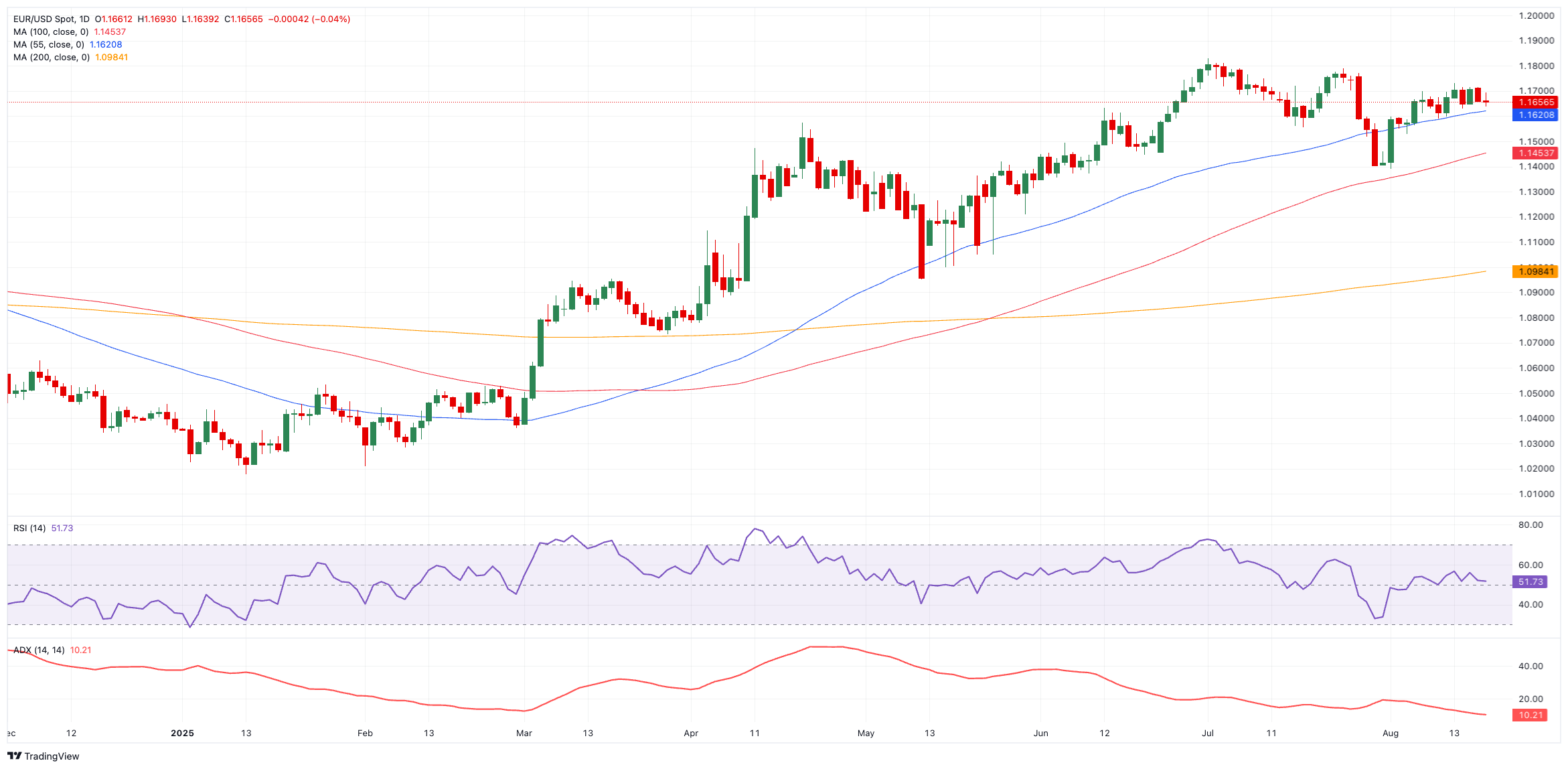
- EUR/USD navigated without clear direction, always below the 1.1700 hurdle.
- The US Dollar remained in the low-98.00s amid unclear price action and lower yields.
- Investors now shift their attention to Wednesday’s release of the FOMC Minutes.
The Euro (EUR) struggled to regain upside traction on Tuesday, prompting EUR/USD to navigate an inconclusive range in the sub-1.1700 region, all against the backdrop of a lack of clear direction in the US Dollar (USD).
A mildly bid US Dollar (USD) weighed on risk sentiment, with traders assessing the Trump–Zelenskiy meeting and the broader geopolitical backdrop. Adding to the wait-and-see mood, investors are eyeing the release of the Federal Open Market Committee (FOMC) Minutes on Wednesday and Jerome Powell’s speech at the Jackson Hole Symposium on Friday.
Trade talks cool tensions, not doubts
Markets have been cheered recently by a temporary truce in global trade tensions. Washington and Beijing struck a 90-day extension to their deal just hours before fresh tariffs were due to kick in. President Trump signed an executive order delaying hikes until November 10, with Beijing promising reciprocal measures. For now, existing tariffs remain in place: 30% on Chinese goods heading to the US and 10% on US exports going the other way.
This came on the heels of a US–European Union (EU) agreement trimming most tariffs on American exports to 15% from a threatened 30%. The EU also pledged $750 billion in US energy purchases, extra defence orders, and over $600 billion in American investments.
Reaction in Europe was mixed, as German Chancellor Friedrich Merz warned the deal could squeeze the continent’s fragile manufacturing sector, while French President Emmanuel Macron labelled it a “dark day” for Europe.
Central banks: Data first, decision later
The Federal Reserve (Fed) kept interest rates unchanged at its last meeting, with Chair Jerome Powell sounding measured, balancing his remarks against dovish leanings from Governors Christopher Waller and Michelle Bowman.
Over in Frankfurt, European Central Bank (ECB) President Christine Lagarde described eurozone growth as “solid, if a little better.” Still, markets have pushed back expectations for the ECB’s first rate cut until spring 2026.
Positioning: Bulls retreat
Speculative appetite for the Euro has cooled. Commodity Futures Trading Commission (CFTC) data through August 12 showed net long positions slipping to a six-week low of about 115.4K contracts. Meanwhile, commercial traders boosted their net shorts above 167K contracts, a two-week high. Furthermore, open interest climbed back to roughly 825K after two weeks of decline.
Trend watch
Resistance stands at the weekly high of 1.1788 (July 24), ahead of the YTD ceiling at 1.1830 (July 1), with the September 2021 peak at 1.1909 (September 3) just below the psychological 1.2000 line.
In the other direction, support comes first at the 100-day Simple Moving Average (SMA) at 1.1460, prior to the August base at 1.1391 (August 1) and the weekly floor at 1.1210 (May 29).
Momentum looks unconvincing. The Relative Strength Index (RSI) has eased below 52, signalling waning upside impulse, while the Average Directional Index (ADX), below 12, continues to flag a weak, trendless market.

Short-term outlook
For now, EUR/USD looks boxed in. A clear break may depend on the Fed’s next steps or a meaningful shift in global trade tensions. Until then, the Dollar remains firmly in the driver’s seat.
Euro FAQs
The Euro is the currency for the 19 European Union countries that belong to the Eurozone. It is the second most heavily traded currency in the world behind the US Dollar. In 2022, it accounted for 31% of all foreign exchange transactions, with an average daily turnover of over $2.2 trillion a day. EUR/USD is the most heavily traded currency pair in the world, accounting for an estimated 30% off all transactions, followed by EUR/JPY (4%), EUR/GBP (3%) and EUR/AUD (2%).
The European Central Bank (ECB) in Frankfurt, Germany, is the reserve bank for the Eurozone. The ECB sets interest rates and manages monetary policy. The ECB’s primary mandate is to maintain price stability, which means either controlling inflation or stimulating growth. Its primary tool is the raising or lowering of interest rates. Relatively high interest rates – or the expectation of higher rates – will usually benefit the Euro and vice versa. The ECB Governing Council makes monetary policy decisions at meetings held eight times a year. Decisions are made by heads of the Eurozone national banks and six permanent members, including the President of the ECB, Christine Lagarde.
Eurozone inflation data, measured by the Harmonized Index of Consumer Prices (HICP), is an important econometric for the Euro. If inflation rises more than expected, especially if above the ECB’s 2% target, it obliges the ECB to raise interest rates to bring it back under control. Relatively high interest rates compared to its counterparts will usually benefit the Euro, as it makes the region more attractive as a place for global investors to park their money.
Data releases gauge the health of the economy and can impact on the Euro. Indicators such as GDP, Manufacturing and Services PMIs, employment, and consumer sentiment surveys can all influence the direction of the single currency. A strong economy is good for the Euro. Not only does it attract more foreign investment but it may encourage the ECB to put up interest rates, which will directly strengthen the Euro. Otherwise, if economic data is weak, the Euro is likely to fall. Economic data for the four largest economies in the euro area (Germany, France, Italy and Spain) are especially significant, as they account for 75% of the Eurozone’s economy.
Another significant data release for the Euro is the Trade Balance. This indicator measures the difference between what a country earns from its exports and what it spends on imports over a given period. If a country produces highly sought after exports then its currency will gain in value purely from the extra demand created from foreign buyers seeking to purchase these goods. Therefore, a positive net Trade Balance strengthens a currency and vice versa for a negative balance.
Information on these pages contains forward-looking statements that involve risks and uncertainties. Markets and instruments profiled on this page are for informational purposes only and should not in any way come across as a recommendation to buy or sell in these assets. You should do your own thorough research before making any investment decisions. FXStreet does not in any way guarantee that this information is free from mistakes, errors, or material misstatements. It also does not guarantee that this information is of a timely nature. Investing in Open Markets involves a great deal of risk, including the loss of all or a portion of your investment, as well as emotional distress. All risks, losses and costs associated with investing, including total loss of principal, are your responsibility. The views and opinions expressed in this article are those of the authors and do not necessarily reflect the official policy or position of FXStreet nor its advertisers. The author will not be held responsible for information that is found at the end of links posted on this page.
If not otherwise explicitly mentioned in the body of the article, at the time of writing, the author has no position in any stock mentioned in this article and no business relationship with any company mentioned. The author has not received compensation for writing this article, other than from FXStreet.
FXStreet and the author do not provide personalized recommendations. The author makes no representations as to the accuracy, completeness, or suitability of this information. FXStreet and the author will not be liable for any errors, omissions or any losses, injuries or damages arising from this information and its display or use. Errors and omissions excepted.
The author and FXStreet are not registered investment advisors and nothing in this article is intended to be investment advice.




